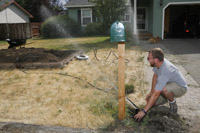"Hello, King's," said the voice on the phone from Hailey.
"Do you sell electric fans?" this reporter asked.
"Let me go see if we have any more," said clerk Brad Hepworth.
He returned to the phone a few moments later. "We have a few." He said he was not exactly sure how many were sold since the hot weather hit around July 4.
"We've sold a lot. Dozens," he said. "We just got (another) shipment in today (July 13)." That means 25 to 30 fans.
Sweltering temperatures have had Idahoans twisting those air conditioning knobs and grabbing fans off store shelves as fast as they come in. Idaho Power Co. has set records for use and is purchasing one-third of its electricity from out-of-state. That means a possible pocket book hit for consumers next spring.
The National Weather Service predicts a high in Ketchum of about 91 today, dropping to 87 on Thursday.
In downtown Ketchum, manager Allan Lum of Chateau Drug was all out of fans for a week and a half.
"They're just flying out of here," he said.
The store had about 25 on hand when the heat wave started in early July, but it ran out.
"We ran out last week when everybody else did," Lum said.
He ordered 100 and they arrived July 12.
"I don't know exactly how many came in," he said. "We've got a lot of fans¾we're ready."
Sizzling temps also mean more meat is sizzling on outdoor grills¾barbecues are also a hot-selling item, Lum said.
Something has got to power all those fans, as well as the increased air conditioning and irrigation that come with hot weather. Idaho Power Co.'s all-time use record was broken twice in early July. On Friday, July 13, when temperatures hit 104 in Boise, the record was topped again when consumers used 3,193 megawatts of electricity.
If you compare electrical use to driving a car, during the heat of the day that car would be going 100 mph or very close to its maximum, explained Russ Jones, corporate communications specialist with Idaho Power Co. Overnight when households are using less electricity, that car would return to a speed of 20-30 mph.
Jones said future rate increases are "very possible." Low water flows caused by last winter's low snowpack mean the utility is producing less hydroelectric power than normal, so it is importing power from other utility companies in the Northwest. The increased costs of imported power could show up on customers' bills, Jones said.
"We will pass those costs on next spring when we apply to the public utilities commission for our (annual) power cost adjustment," he said.
Jones said it's hard to say how much rates might rise. He said the power cost adjustment reflects changing power costs, but added that the company filed a separate, permanent rate increase request with the public utilities commission on June 6.
Residential customers pay 5.9 cents per kilowatt-hour during the summer and now the utility is buying the off-system power for between seven and ten cents per kilowatt-hour, Jones said.
But just as there is a good possibility that rates will go up, if there is good snowfall and run-off by spring, they could go down or cancel any increase, Jones said. Conservation by consumers could have an effect on the power cost adjustment, he said.
In 2006, 44 percent of Idaho Power's electricity production came from hydroelectric sources and that number will likely drop this year, Jones said. Thermal or coal-powered plants produced 33 percent of the company's needs, and that percentage will likely rise. The remainder, 23 percent, was purchased outside the system, a figure also likely to increase.
Idaho Power serves 475,000 customers throughout most of Idaho, from Blackfoot in the east to eastern Oregon in the west, and as far north as Salmon and Riggins in the central part of the state.
People are not the only ones wilting under temperatures that have ranged consistently into the low 90s in the Wood River Valley. Plants will wilt and stress out just like people, said Moss Garden Center manager Jason Kindred.
"The water requirements for the plants really go up when it goes into the 90s," he said.
He added that dry winds add to the problem.
Kindred said that during cooler weather, garden center employees water nursery plants once or twice a day; now they water twice or three times a day.
"That's pretty much all our plants," he said.
He suggested that all plant owners increase their watering. He said that if plants get stressed, they become more susceptible to insect infestations. He recommended that gardeners use an organic insecticide to combat that.


 Willy Felton of the Woodside neighborhood in South Hailey pours it on. Lawns and gardens need extra water in the current heat wave, garden experts say. Photo by David N. Seelig
Willy Felton of the Woodside neighborhood in South Hailey pours it on. Lawns and gardens need extra water in the current heat wave, garden experts say. Photo by David N. Seelig



































